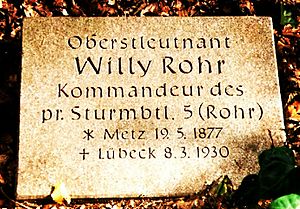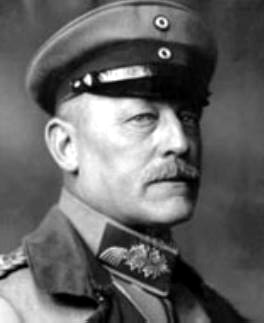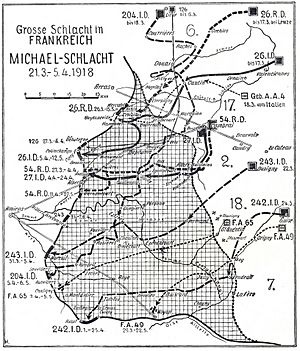Infiltration tactics facts for kids
During World War I, new ways of fighting were developed to break the tough trench warfare. Two important German generals, Willy Rohr and Oskar von Hutier, created special tactics that changed how battles were fought.
Willy Rohr developed what were called Shock-Troops-Taktiks in 1915 on the Western Front. These tactics were first used successfully in the Battle of Verdun. His special group of soldiers became known as Sturmbataillon Rohr. About a year later, it was officially renamed by the Prussian Minister of War to Sturm-Bataillon Nr. 5 (Rohr). These stormtroopers were trained to quickly attack enemy trenches.
Oskar von Hutier was another very successful and creative German general. He developed similar new tactics on the Eastern Front. After becoming an army commander in 1917, Hutier used what he had learned from his years leading troops. He also studied tactics used by other armies. He then created a new plan for the Germans to break the deadlock of trench warfare. These tactics worked so well in 1917 and 1918 that the French called them "Hutier tactics." Today, they are more commonly known as "infiltration tactics."
Operation Michael: A Big Attack
In 1918, the German army launched a series of major attacks called the Spring Offensive. The first and biggest part was named Operation Michael. It began on March 21, 1918. The Germans used three armies, with a total of 42 divisions (large groups of soldiers).
The main goal was to break through the enemy lines where the French forces met the British forces. This was between the towns of Bapaume and Saint Simon. The Germans wanted to create a gap between the two Allied armies. Their plan was to push the British army towards the sea.
On the very first day, the German attack broke through the defensive lines of both the British and French. The Germans advanced about 65 kilometers (about 40 miles) deep into enemy territory. This created a bulge in the front line, about 80 kilometers (50 miles) long. The German troops faced more resistance from the British than from the French.
However, even though the Germans had great success at first, their attack soon ran out of steam. By March 27, the French began to bring in their reserve troops near Amiens. At this point, the Germans could not gain much more land. So, the Germans failed to win a truly important strategic victory. Instead, their attack made the battle line longer and created a bulge that was open to Allied counter-attacks.
Images for kids
-
Mix of new and old French tactics help capture Neuville-Saint-Vaast, but with heavy casualties, 9 May – 9 June 1915, as part of the Second Battle of Artois
-
Map detailing exact positions and timing of the planned creeping barrage for the Canadian assault on Vimy Ridge, April 1917
-
8-inch howitzers of the 39th Siege Battery, Royal Garrison Artillery conducting a bombardment in the Fricourt-Mametz Valley, August 1916, during the Battle of the Somme












